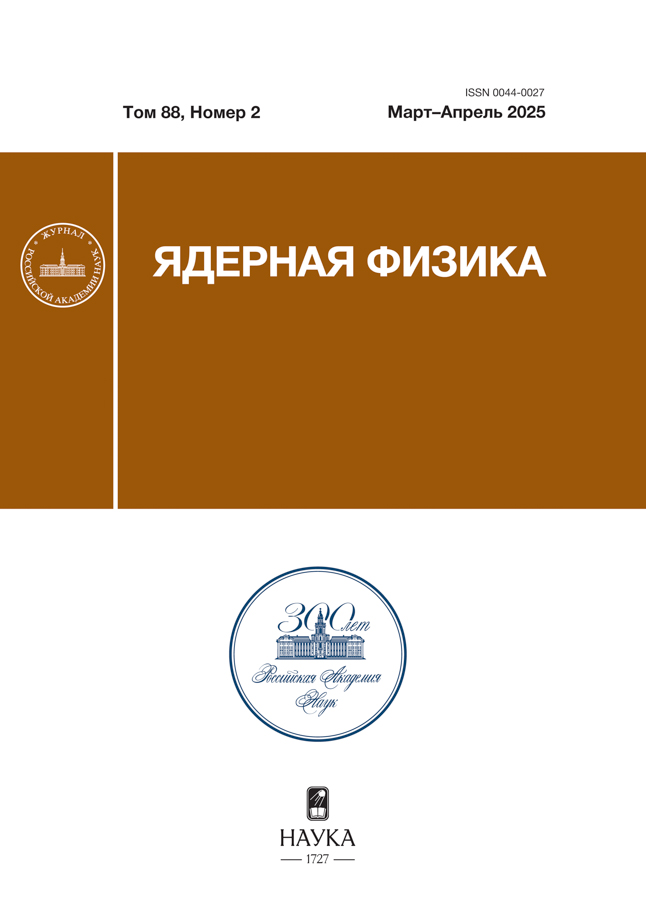Determining low-energy characteristics of the pp interaction in the d + 1H → p + p + n reaction
- Авторлар: Kasparov A.A.1, Mordovskoy M.V.1, Mitsuk V.V.1, Lebedev V.M.2, Spassky A.V.2
-
Мекемелер:
- Institute for Nuclear Research of Russian Academy of Sciences
- Moscow State University
- Шығарылым: Том 88, № 2 (2025)
- Беттер: 220-227
- Бөлім: PROCEEDINGS OF 74TH INTERNATIONAL CONFERENCE ON NUCLEAR PHYSICS “NUCLEUS-2024: FUNDAMENTAL PROBLEMS AND APPLICATIONS”, 1–5 JULY 2024, DUBNA, RUSSIA. Elementary particles and fields. Experiment
- ##submission.datePublished##: 04.06.2025
- URL: https://clinpractice.ru/0044-0027/article/view/683929
- DOI: https://doi.org/10.31857/S0044002725020063
- EDN: https://elibrary.ru/GKXCSL
- ID: 683929
Дәйексөз келтіру
Аннотация
The study results of the d + 1H → p + p + n reaction are presented. A kinematically complete experiment with using a deuteron beam energy of 15.3 MeV at the U-120 accelerator of the MSU SINP was carried out. A proton from the breakup of the singlet pp state and a secondary neutron were registered in coincidence. As a result of the study, the low-energy characteristics of pp interaction, namely, the energy value of the virtual singlet pp state and the corresponding value of the pp scattering length were determined.
Толық мәтін
Авторлар туралы
A. Kasparov
Institute for Nuclear Research of Russian Academy of Sciences
Email: vyacheslavmitsuk@yandex.ru
Ресей, Moscow
M. Mordovskoy
Institute for Nuclear Research of Russian Academy of Sciences
Email: vyacheslavmitsuk@yandex.ru
Ресей, Moscow
V. Mitsuk
Institute for Nuclear Research of Russian Academy of Sciences
Хат алмасуға жауапты Автор.
Email: vyacheslavmitsuk@yandex.ru
Ресей, Moscow
V. Lebedev
Moscow State University
Email: vyacheslavmitsuk@yandex.ru
Skobeltsyn Research Institute of Nuclear Physics
Ресей, MoscowA. Spassky
Moscow State University
Email: vyacheslavmitsuk@yandex.ru
Skobeltsyn Research Institute of Nuclear Physics
Ресей, MoscowӘдебиет тізімі
- V. G. J. Stoks, R. A. M. Klomp, C. P. F. Terheggen, and J. J. de Swart, Phys. Rev. C. 49, 2950 (1994).
- Е. С. Конобеевский, С. В. Зуев, М. В. Мордовской, С. И. Поташев, И. М. Шарапов, ЯФ 76, 1479 (2013) [Phys. At. Nucl. 76, 1398 (2013)].
- C. Bäumer, D. Frekers, E.-W. Grewe, P. Haefner, S. Hollstein, B. C. Junk, A. Korff, S. Rakers, R. Schmidt, A. M. van den Berg, B. Davids, M. N. Harakeh, M. Hunyadi, M. A. de Huu, H. J. Wörtche, N. Blasi, et al., Phys. Rev. C 71, 044003 (2005).
- Е. С. Конобеевский, С. В. Зуев, A. A. Каспаров, В. И. Кукулин, В. М. Лебедев, М. В. Мордовской, В. Н. Померанцев, А. В. Спасский, ЯФ 81, 555 (2018) [Phys. At. Nucl. 81, 595 (2018)].
- Е. С. Конобеевский, А. А. Афонин, С. В. Зуев, А. А. Каспаров, В. М. Лебедев, В. В. Мицук, М. В. Мордовской, А. В. Спасский, Изв. РАН. Сер. физ. 84, 492 (2020) [Bull. Russ. Acad. Sci.: Phys. 84, 378 (2020)].
- Е. С. Конобеевский, А. А. Афонин, А. А. Каспаров, В. М. Лебедев, В. В. Мицук, М. В. Мордовской, А. В. Спасский, С. В. Зуев, Изв. РАН. Сер. физ. 85, 685 (2021) [Bull. Russ. Acad. Sci.: Phys. 85, 530 (2021)].
- A. A. Kasparov, M. V. Mordovskoy, V. V. Mitsuk, V. M. Lebedev, and A. V. Spassky, Bull. Russ. Acad. Sci.: Phys. 88, 1189 (2024).
- J. R. Bergervoet, P. C. van Campen, W. A. van der Sanden, and J. J. de Swart, Phys. Rev. C 38, 15 (1988).
- H. Brückmann, W. Kluge, H. Matthäy, L. Schänzler, and K. Wick, Phys. Lett. B 30, 460 (1969).
- Zhang Ying-ji, Yang Jin-qing, Zhang Jie, and He Jian-hua, Phys. Rev. C. 45, 528 (1992).
- G. A. Miller, B. M. K. Nefkens, and I. Šlaus, Phys. Rep. 194, 1 (1990).
- А. А. Каспаров, М. В. Мордовской, А. А. Афонин, С. И. Поташев, В. В. Мицук, ЯФ 86, 245 (2023) [Phys. At. Nucl. 86, 44 (2023)]
- В. И. Кукулин, В. Н. Померанцев, О. А. Рубцова, М. Н. Платонова, ЯФ 82, 521 (2019) [Phys. At. Nucl. 82, 934 (2019)].
Қосымша файлдар
















